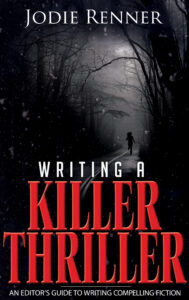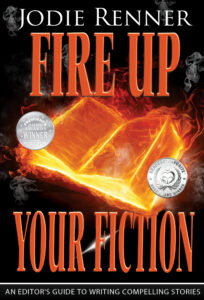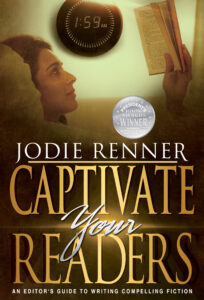by Jodie Renner, fiction editor & author of writing guides
 Are you in the process of writing a novel? Maybe a thriller or other popular fiction that you hope will grab readers and really sell? Besides a great character and a fascinating plot, you’ll also need some tried-and-true fiction-writing techniques to take your story up a level or three.
Are you in the process of writing a novel? Maybe a thriller or other popular fiction that you hope will grab readers and really sell? Besides a great character and a fascinating plot, you’ll also need some tried-and-true fiction-writing techniques to take your story up a level or three.
To keep readers engaged and eagerly turning the pages, all genres of fiction, not just thrillers, need tension and intrigue – and a certain amount of suspense. And of course, you’ll need to ratchet up the tension, intrigue, and suspense a lot more if you’re writing a fast-paced, nail-biting, page-turner.
Here are some techniques for engaging your readers and keeping them riveted:
~ First, create a protagonist that readers will care about, and give him some worries and secrets. Make your hero or heroine intriguing and complex, clever and resourceful. But not perfect – make them vulnerable too, with an Achilles heel and some inner conflict, regrets, and secrets. In most cases, you want your protagonist to be likeable too, or at least have some endearing traits to make readers worry about her and root for her. If readers can’t identify with or bond with your character, it’s pretty hard to make them care what happens to her. Essential Characteristics of a Thriller Hero
~ Get up close and personal. Use deep point of view (first-person or close third person) to get us into the head and body of your main character right from the opening paragraph. Show his thoughts, fears, hopes, frustrations, worries, and physical and sensory reactions in every scene. Engage Your Readers with Deep Point of View.
~ Show your hero or heroine in action in the first paragraphs. Rather than opening with description, background info, or your character alone musing, it’s best to jumpstart your story with your lead interacting with someone else who matters to them, preferably with a bit of discord and tension. And show his/her inner thoughts and emotional reactions, maybe some frustration or anxiety. Act First, Explain Later.
~ Give your character a problem to solve right from the get-go. It can be minor, but creating an early conflict that throws your lead off-balance will make your readers worry about him. A worried reader is an engaged reader.
~ Withhold information. Don’t tell your readers too much too soon. This is so important and a common weakness for new fiction writers. Hold off on critical information. Hint at a traumatic or life-changing event early on, then reveal fragments of info about it little by little, through dialogue, thoughts, and brief flashbacks, to tantalize readers and keep them wondering and worrying.
~ Keep the story momentum moving forward. Don’t get bogged down in lengthy descriptions, backstory, or exposition. Keep the action and interactions moving ahead, especially in the first chapter. Work in background details and other info little by little, on an “as-needed” basis, through dialogue or flashbacks – not as the author/narrator interrupting the scene to explain things to the readers. See my blog post Don’t Stop the Story to Introduce Each Character!
~ Introduce a significant, meaningful story problem. Now that your readers care about your main character, insert a major challenge, dilemma, goal, or threat within the first ten chapters, a big one that won’t be resolved until the end. Create an overarching sentence about this to keep in mind as you’re writing your story:
“Will (name) survive/stop/find/overcome (ordeal/person/difficulty/threat) on time?”
~ Show, don’t tell. Show all your critical scenes in real time as they’re happening, with action, reaction, and dialogue. Show your main character’s inner feelings and physical and emotional reactions. Don’t explain as the author or narrator – stay in the character’s viewpoint. And don’t have one character tell another about an important event or scene after it happened. Instead, show that scene as it’s unfolding or as a flashback. Of course, briefly narrate or “tell” transition scenes. Tips for showing instead of telling.
~ Make use of compelling, vivid sensory imagery to take us right there, with the protagonist, vividly experiencing and reacting to whoever/whatever is challenging or threatening him. Show his reactions to his environment, including what he’s seeing, hearing, smelling, touching, even tasting, and also any discomfort – is he hot, cold, tired, stressed, hungry, thirsty, afraid? Is sweat pouring down his back? Are his feet sore? These details bring him to life for the readers, who feel that hunger, thirst, fatigue, or discomfort too. 
~ Use brief flashbacks at key moments to reveal your viewpoint character’s childhood traumas, unpleasant events, secrets, emotional baggage, hangups, dysfunctional family, etc. Show these in real time for greater impact.
~ Insert some conflict/tension and a change into every scene. There should be something unresolved in every scene. Your character enters the scene with an objective or goal (agenda), but she encounters obstacles in the scene, so she is thwarted in her efforts to reach her goal. By the end of the chapter or scene, she or circumstances have changed.
~ Put tension on every page. Every page needs some tension, even if it’s just doubt, questioning, disbelief, disagreement, suspicion, or resentment simmering below the surface.
~ Add in tough choices and moral dilemmas. Devise ongoing difficult decisions and inner conflict for your lead character. Besides making your plot more suspenseful, this will also make your protagonist more complex, vulnerable, and intriguing.
~ Delay answers to critical plot questions. Look for places in your story where you’ve answered readers’ questions too soon, so have missed a prime spot to increase tension and suspense. Draw out the time before answering that question. In the meantime, hint at it from time to time to remind readers of its importance.
~ Plan a few plot twists. Readers are surprised and delighted when the events take a turn they never expected. Don’t let your readers become complacent, thinking it’s easy to figure out the ending, or they may stop reading.
If you’re writing a thriller or other suspense fiction, ratchet up the tension and conflict even more with these techniques:
~ Create a cunning antagonist. Your villain needs to be as clever, determined and resourceful as your protagonist – or even more so. Make him or her a serious force to be reckoned with! See my post here on TKZ, Create a Fascinating, Believable Antagonist.
~ Ratchet up the problem to a serious threat, and make it personal. Your hero or someone he cares about is personally threatened. It’s a life-or-death situation.
~ Establish a sense of urgency, a tense mood, and generally fast pacing. Do this by your choice of words and tight writing.
~ Use the setting to establish the mood and create suspense. This is the equivalent of ominous music, harsh lighting, strange camera angles, or nasty weather in a scary movie.
~ Create a mood of unease by showing the main character feeling apprehensive about something or someone or by showing some of the villain’s thoughts and intentions.
~ Keep hampering your hero or heroine throughout the novel to increase worry, tension, and suspense. Stir in some of these ingredients: a ticking clock, obstacles, chases, traps, restrictions, handicaps, injuries, bad luck, etc.
~ Keep raising the stakes. Keep asking yourself, “How can I make things worse for the protagonist?” As the challenges get more difficult and the obstacles more insurmountable, readers worry more and suspense grows.
~ Get us into the head of the villain too. For increased anxiety and suspense, show us the thoughts and intentions of your antagonist from time to time. This way the readers find out critical information the hero or heroine doesn’t know, things we desperately want to warn her about!
~ Use foreshadowing to incite curiosity. Tease the readers with innuendos. Drop subtle hints of troubles to come. Hint at the main character’s past secrets. What is the character worried about or afraid might happen? Capitalize on this. For more specific tips on this technique, see my TKZ article, Fire up Your Fiction with Foreshadowing.
 ~ Add in some revelations and epiphanies to put a twist on things and reward readers for their interest and involvement.
~ Add in some revelations and epiphanies to put a twist on things and reward readers for their interest and involvement.
~ Use cliff-hangers. Put your hero or heroine in hot water at the end of some chapters to incite reader curiosity and questions and compel them to go to the next chapter. Then maybe use a jump cut to go to a different scene, so they have to read more to find out what happened in the previous chapter.
For a list of techniques to consider when writing suspense fiction, see my Checklist for Adding Suspense & Intrigue here on TKZ.
Then, in the Revision Stage:
~ Amp up, condense, or delete any scenes that lag, and tighten up your writing. Are some of your sentences and paragraphs too long? Are you inadvertently repeating words, ideas, actions, or imagery in close proximity? Go back and make sure every scene, paragraph, sentence, and word enhance the story and drive the plot forward. Critical Scenes Need Nail-Biting Details.
Use short paragraphs and mix it up with brief narration and snappy dialogue. Vary the sentence structure and length. Use shorter sentences at tense times. More tips: Pick up the Pace for a Real Page-Turner.
~ Word choice is critical too. Vary your words. Use specific, evocative nouns, and verbs that really capture the action and add tension, rather than overused ones like “walked” and “ran.” For examples and more, see Nail it with Just the Right Word.
Have some of these techniques worked for you? Which ones do you find the most helpful in your own writing? Do you have any other tips to help new suspense fiction writers create a novel that will captivate readers, sell lots of copies, and garner great reviews? Or examples from your own work or a bestselling novel you’ve read? Let us know in the comments below.
 Jodie Renner is a freelance fiction editor and the author of three writing guides in her series An Editor’s Guide to Writing Compelling Fiction: Captivate Your Readers, Fire up Your Fiction, and Writing a Killer Thriller. You can find Jodie at www.JodieRenner.com, at her Amazon Author Page, her blog Resources for Writers, and on Facebook.
Jodie Renner is a freelance fiction editor and the author of three writing guides in her series An Editor’s Guide to Writing Compelling Fiction: Captivate Your Readers, Fire up Your Fiction, and Writing a Killer Thriller. You can find Jodie at www.JodieRenner.com, at her Amazon Author Page, her blog Resources for Writers, and on Facebook.

Fantastic tips, Jodie! I’m especially fond of jump cuts. It’s an effective way to keep readers flipping pages late into the night.
Thanks, Sue. As a voracious reader of suspense fiction, I love jump cuts too. I find them deliciously frustrating, as they compel me to read yet another chapter to get back to that other scene where we were left hanging. Then the skilled author will often end the new scene with a cliff-hanger and employ another jump cut to take us back to the original scene. Love it!
Jodie,
Wonderful to see you back in the Zone!
I remember reading most of your links to past posts when they originally came out. Your advice played a huge role in my education.
When I first discovered TKZ (and, through that, your books), I’d written ten novels that earned rave rejections but still fell short of publication. In #11, I put your techniques to work, won two major contests, and snagged a contract.
Thanks so much for your kind words, Debbie. I’m so glad you found my craft posts helpful when I was a regular here on TKZ and afterward. (By the way, I regularly use the TKZ library for finding my own posts and recommending articles by others here to my writer clients.)
I’m sure you had the creativity, the drive, the can-do attitude, and the talent all along, but it’s satisfying to know that some of my advice helped you hone your fiction-writing techniques to the point where your stories won contests and snagged you a contract. Kudos to you!
Excellent tips. The most common shortfall in the manuscripts I critique is the failure to create a sympathetic character. This is especially true in science fiction. Fantastic worlds, technical details that ring true, and harrowing adventures fall flat if the reader doesn’t care about your protag.
I absolutely agree with you, Mike. I think sci-fi, fantasy, and action-adventure writers sometimes get too caught up in the plot and action and forget how important it is to engage the readers emotionally by making them really care about the main character and identify with him/her. Making the protagonist more likeable and vulnerable and using deep point of view will help that immensely.
BTW, I keep Fire Up Your FIction at my writing desk. It’s the best compact guide I’ve found for getting me out of a writing roadblock.
Excellent! So nice to hear, Mike. (If you haven’t reviewed it on Amazon, a few words or a single sentence would work just fine! 😉 )
Glad to!
Awesome! Thanks, Mike! 🙂
Thank you, Jodie, for this wonderful article. It’s like having an entire writing course in one blog post — I’m bookmarking this one!
I write cozy mysteries, so I can’t identify the real antagonist and show his/her thoughts. The point is to keep the reader guessing, so I see my job as creating several characters who behave in ways that readers can imagine them to be the villain. I believe this makes for a more complex story and engages the reader into the hunt for the killer.
I also love cliff-hanger chapter endings.
Thanks so much for your kind words, Kay. I’m glad you found my tips helpful, even though the second section is geared to thrillers, not cozy mysteries. I so admire the skills of mystery writers in creating several characters who could be the killer, and love the end results as the reader!
How many of us saw “concrete” and the image of a gangster, a bucket of concrete, and a body of water came to mind? Just me? Never mind.
Excellent article! My addition is to make the main goal worthwhile and something the reader really, really wants to happen through the whole book. Solving the murder when the victim is so nasty that the reader only wants to pat the killer on the back and say “well done” isn’t an emotionally invested goal. Proving that the murder wasn’t suicide so the widow and her young children can get the insurance payout involves the reader emotionally in the solution. Heck, even then, turn one of the kids into Tiny Tim who needs the money for a life-saving medical treatment to make it even better.
Marilynn, I had exactly the same reaction to the word “concrete.” I could see the cement block tied around the guy’s ankle as he was tossed into the ocean.
Ha ha. I didn’t even think of that when I used the word “concrete”! LOL.
I love your point about making the main goal “worthwhile and something the reader really, really wants to happen through the whole book.” Excellent point. And I really like your examples. I think I’ll go back and add a few words to the article in light of your excellent suggestion. Thanks!
Thank you, Jodie, for the great post…great craft teaching, as usual here at TKZ. Copied and pasted for future study and application. 🙂
Thanks, Deb. I’m so glad you found my tips helpful. Feel free to share the post on social media! 😉
Welcome back, Jodie.
A fantastic list of tips and advice. Learning to write a story that works can be a lengthy process, because there are so many moving parts. This lays out many of those parts. I’ve used your book, “Captivate Your Readers” repeatedly over the past few years, ever since I was fortunate enough to provide a little reader feedback for you. I also own “Fire Up Your Fiction,” which is excellent as well.
Great to see you here again!
Thanks so much for your kind comments, Dale. I’m glad you find this list helpful. Feel free to share it with any other writers you know. 🙂
And thanks for being a beta reader for my third writing guide, Captivate Your Readers, several years ago. I’m thrilled that you still find it and Fire up Your Fiction useful! Good luck with all your writing projects!
I purchased Writing A Killer Thriller two years ago. My project that starts today?
Go back and re-read it.
Welcome back.
Thanks, Jim. I also recommend Fire up Your Fiction, which has great ratings on Amazon! Good luck with your WIP and all your writing projects!
Late to TKZ today and great to see the editor of the first three books in my series visiting.
Not everyone can have the advantage of your skills as their editor but all can buy your books and benefit from your writing wisdom!
Thank you, Jodie!
Thank you so much for your kind words, Tom! Your endorsement of my fiction-writing advice means a lot, coming from a highly talented, bestselling thriller author like you!
This a great, easy to follow, list of tips. As soon as I finished reading it I opened up my current manuscript and started checking how many of these I’ve used, and how many more techniques I can add in. Thank you, Jodie!
Thanks, Matt. It always makes me feel good to know that my tips have inspired someone to spark up their WIP in various ways! Good luck with your revisions/additions/tightening up!
Excellent article.
Pingback: Top Picks Thursday! For Writers & Readers 09-24-2020 | The Author Chronicles